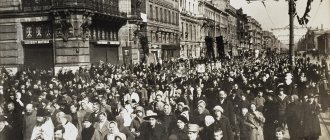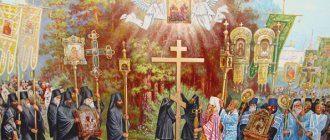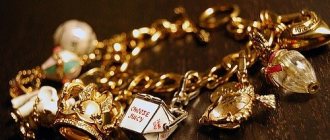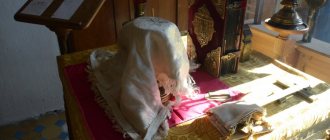About the two- and three-fingered sign of the cross (Editorial commentary)
Today, the enemy of our salvation has again raised the long-forgotten topic of the Old Believers. We, considering it our duty not to be among those who betray God with silence, had a short conversation with two people who, in our opinion, were knowledgeable on this issue. This is the chairman of the Missionary Department at the Rehabilitation Center, priest Ioann Kornienko, and history teacher Valentin Stepanovich Proskurin.
Today they are talking again about the fact that the Old Believers allegedly retained the true faith. Is it really?
O. John: I would not like to offend anyone, and therefore, if you allow, I will start not with the Old Believers, but with Renovationism. Many readers are familiar with modern renovationists, such as Fr. Georgy Kochetkov and Fr. Alexander Borisov.
These people supposedly care about the return of old traditions. They organize Agapes, so-called love suppers, making sure that the priests are chosen by the parish, and not appointed by the bishop, so that the community is the same as that of the first Christians. They translated the service into Russian, assessing their renovation work at the level of the activities of Saints Cyril and Methodius, Slovenian teachers, while considering themselves fighters for the return of the ancient traditions of the Church. But in reality they are innovating and preaching ecumenism.
Do you understand what I'm talking about? The Old Believers were the same renovationists. Two-fingered, especially alleluia and other so-called old rituals were in fact an innovation that these would-be theologians tried to introduce into Church use.
Open the book “The Journey of the Antiochian Patriarch Macarius to Russia in the middle of the 17th century,” described by his son and fellow traveler Archdeacon Pavel of Aleppo, and you will see how faithful the people in Russia were to Orthodoxy at that time. Shortly before Nikon, the patriarchal throne was occupied by Isidore, who tried to sign a union with the Latins - he was expelled from Russia in disgrace.
Imagine now that Patriarch Nikon would decide to introduce some innovations? The reaction of the people would have been so violent that he would have been in great pain.
Historian V.S. Proskurin: History confirms that all these so-called old rituals were only a matter of debate. Neither double-fingering nor pure alleluia were widespread among the people. Everyone was baptized unanimously in the same way as in our time - with three fingers. And in the temples they sang hallelujah three times - just like now.
But there were such florid theologians, like today's Kuraevs, Osipovs and other vain talkers, who suddenly announced that we are all baptized incorrectly. Look, they say, at the icons and you will see that there are saints and the Lord Himself depicted with two fingers. And confusion began among the common people. Some believed these impostors, but others did not. In fact, there were initially few Old Believers. Just Avvakum and noblewoman Morozova. There wasn't even a single bishop among them. Why? Yes, because it was an innovation that the bishops did not want to accept.
Is it really possible to admit that among the heroes of the spirit of that time there was not a single worthy bishop who would not agree to accept triplicate if it were an innovation?
(a very compelling argument! It is impossible to imagine that at that pious time there would not have been a single bishop-confessor who stood up for the defense of the truth. They didn’t stand up for the defense only because the truth was not trampled upon - Ed.)
So, double-fingering was not an ancient tradition, but an innovation?
O. John: The fact of the matter is that the innovation was not three-fingered, but two-fingered. That is why the schismatics found themselves without bishops, and subsequently without priests at all.
As for the three- or two-fingered addition for the sign of the cross and blessing, Old Believers often refer to the “Pomeranian Answers,” compiled in 1722 in response to 106 questions of Hieromonk Neophytos by Vygov schismatics. Bezpopovites Andrei Denisov, his brother Simeon and Trifon Petrov worked on compiling the “Pomeranian Answers”. “Pomeranian Answers” are full of florid turns and represent a kind of non-priest dogma. But in the 19th century. and the priests willingly began to refer to this work, entering into polemics with the Orthodox Church.
So, in these very answers, the Pomeranians cite as evidence the Korsun cross and icons depicting the Savior and saints with a blessing hand. But the nominal blessing, which is given only to those who are ordained and which is depicted on the icons of the Lord and saints, has always differed from the usual making of the sign of the cross.
Bezpopovtsy write that the Rev. Peter of Damascus says: “Two fingers and one hand reveal the crucified Lord Jesus Christ, who is knowable in two natures and in one composition.” But we also affirm the same thing when we talk about the blessing hand of the Savior. The saint does not say that one should mark oneself in this way. On the contrary, he speaks of the figurative sign depicted on holy icons.
I won’t bother you with polemics, but I’ll just say that the attempt to mix the nominal sign of the finger with the usual sign of the cross led the non-priest “theologians” of that time to the opinion that the double finger is a dogma. By the way, when asked whether tripartite morphology is a heresy, the Denisovs answered: “we do not dare to impose a judgment on tripartite morphology.”
But there is an obvious contradiction here, right?
Historian V.S. Proskurin: You noticed absolutely exactly. Old Believers admit a three-fingered constitution and at the same time believe that two-fingered is a dogma. There are plenty of contradictions, crafty twists and generally outright lies in these Pomeranian answers. Metropolitan Macarius Bulgakov wrote about this back in his time.
When you ask the Old Believers why the Holy Fathers wrote a lot about the dogmas of the Trinity, Christ, the Mother of God and others, but we don’t find any of them about two-fingered fingers, even reference 31 of the Rule of the Hundred Head Council on Blessed. Theodoret and Meletius is not confirmed by their writings, then schismatics usually answer that, they say, all the writings about two-fingered fingers have been lost. But the rule of the Council of the Hundred Heads itself does not explain that it is talking about two fingers, as the overshadowing of oneself.
This rule is entitled “On the sign of the cross: how it is appropriate for a bishop and a priest to bless with his hand, and to be signified by other Orthodox Christians and to worship.” As you can see, it talks not only about overshadowing oneself, but also about how those who are ordained should bless.
At the beginning, the rule speaks specifically about the name-glorifying blessing: “joining the thumb and two lower fingers into one, and joining the upper finger with the middle finger, extending it slightly, so as to bless the Saint and the priest.” It further says that “make the sign of the cross on yourself with your hand, two fingers,” but it does not say how. But at the very end of the rule it is explained: “Have two fingers inclined, and not extended (that is, pressed to the palm - ed.), and those decree thus imagine two natures - Divinity and humanity, God according to Divinity, and man according to humanity , but in both it is perfect, the upper finger forms the Divinity, and the lower one, humanity, having yet descended from the highest of our salvation, will also be interpreted as death: bow down for the heavens came down for our salvation...”
O. John: By the way, we are now reading the decrees of the Stoglavy Council in the edition of the Old Believers, so we must treat what they published with great caution. At that time, the Russian Church was attacked by the Latins, who crossed themselves with the palm of their hand, which was first placed on the left shoulder and then on the right. This was the reason that the question of blessing and making the sign of the cross arose at the Council, and it was decided that, contrary to the Latin waving: “If anyone does not bless with two fingers, like Christ, or does not imagine the sign of the cross with two fingers; May he be cursed, as the Holy Fathers rekosha. The fathers clearly explained that if someone does not bless with a name sign (the Latins used to bless with the palm of their hand), or simply offers their hand, as the Latins did, without depicting the sign of the cross, let him be anathema.
The fact that in order to sign oneself with the sign of the cross one must put three fingers together is written in the book “The Tablet” of Damascus, a Studite subdeacon. This book was first published in 1568 in Venice by Orthodox Greeks.
Even the three-fingered arrangement of the holy right hand of St. Apostle Andrew, which Patriarch Parthenios of Constantinople sent to Russia in 1644, turned out to be unconvincing for the Old Believers.
What do you say about the special alleluia?
Historian V.S. Proskurin : Habakkuk does not deny that there was originally a threefold Alleluia. In his own life, he wrote: “Until Vasily, angelic speeches began to flow in the church: alleluia, alleluia, alleluia! When Vasily came, he commanded to sing two angelic speeches, and a third, human one: Alleluia, Alleluia, glory to you, God!”
Referring to his own simplicity, Habakkuk does not point to the mysterious source from which he learned that St. Basil the Great abolished what was commanded by the holy apostles.
And it turned out to be slander against the saint: it turns out that St. Vasily could easily take it and cancel it.
By the way, St. Athanasius the Great, in his interpretation of Psalm 104, writes: “Alleluia means: praise to the Invisible. They say that with this word the angels praise God, like the cherubs with the words: holy, holy, holy. And in the interpretation of Psalm 134: “...praise the Lord”; because the word “Hallilu” is interpreted as “praise,” and the word “ya” is “Lord.”
Some believe that it is necessary to leave the Orthodox Church of the MP because of the signing by its representatives of the Balamand and Chambesy unions - agreements with Catholics and Monophysites. Since the Chambesian Union implies the removal of anathemas from all former Councils, which has never happened in the Church?
O. John: There have been no unions in the Church and there never will be. She is holy and fragile, and the gates of hell will not prevail against her. And if one of the wicked signed some illegal documents on behalf of the Church, then this does not harm the Church of God at all. They signed a treacherous union, they will burn in hell for this if they do not repent.
We know from the history of the Church that all the eastern bishops signed a union with Rome, and only one bishop, Mark of Ephesus, refused to be an accomplice to this lawlessness. However, he did not leave the Church and did not create his own anti-Unitarian or true one. He remained in the Church and stood in the Truth, fighting for it to the end.
Historian V.S. Proskurin: Also during the time of the Monothelite heresy, historians point out that the entire East was engulfed by it. However, Rev. Maxim the Confessor did not leave the bosom of the Church, but remained a faithful son of his Church. Will a son leave his mother in trouble? Never.
Why is the idea of the Old Believers dangerous?
O. John: On the one hand, because a person, burning with zeal for God, can, without understanding it, come under the wing of schism. On the other hand, having come to terms with the idea that the Church has already deviated from the Truth more than once, he will acquire the skill of lukewarmness and will no longer fight to maintain purity in the Church.
Today they are trying to connect the Old Believers and the fight with electronic chips that contain the number of the beast. Like, just as the Old Believers went into schism because of their rituals, so they say, these fighters with the INN will go into schism.
It’s not true, the Orthodox are not going to go into any schism. And as for the heretical bishops who today trample on the Orthodox teaching of the Church, we hope that God will give us an Orthodox Tsar who will convene a Council, and all these new heresies, such as ecumenism, renovationism and others, will be anathematized, along with those who spread their heretics. And as long as we don’t have a Father Tsar, and we can’t put an end to this anti-Russian colossus, we will stand in the Truth on our native land, in our true Church of the Moscow Patriarchate and fight for it to the last drop of blood.
Interviewed by Igor Belanov
https://www.christian-spirit.ru
Deacon Igor KarvanenTwo-finger sign of the cross
About the two-fingered sign of the cross, and why Old Believers confess it to be true and commanded to us by Jesus Christ.
Since the division of the Russian Orthodox Church in 1654-1667. For supporters of the old and new rites, the sign of the cross with two fingers became a symbol of the Old Believers. These are the words of Archpriest Avvakum
“
So be baptized, and you will be saved,
” and
the noblewoman Morozova
, depicted in the famous painting by Surikov, with her hand raised high, making the sign of the cross over people.
Today many people ask the question: “ I wonder why in those years thousands of people gave their lives for what seemed to be such a narrow ritual understanding of Orthodoxy? What difference does it make - how to cross yourself, with two or three fingers? After all, the teaching of Christ is much higher and broader than these ritual trifles.
" It is impossible to answer this question without a deep and thoughtful study of the problem, and yet, let’s try to do it.
Blessed Theodoret
, Bishop of Cyrus (393-466), a participant in the 3rd and 4th Ecumenical Councils, writes how to be baptized and bless: “Having
three fingers together is equal, the great one, and the last two - the mystery of the Trinity is confessed, God the Father, God the Son, God the Holy Spirit.
There are not three Gods, but one God Trinity. The names are separated, but the Divinity is one. The Father is not begotten, and the Son is begotten of the Father, and not created; The Holy Spirit is not born, not created, but comes from the Father. Three in one Godhead, one power, one honor, one worship from all creation, from angels and from people. This is the decree with that three finger. And put two fingers, the upper one (index)
and the middle one, together and stretch them out
(keep them straight).
Holding the great finger slightly inclined, it forms the two natures of Christ - Divinity and humanity.
God by Divinity, and man by incarnation, is perfect in both. The upper finger forms the Divinity, and the lower one represents humanity, since it came down from the highest to save the lower one. The inclination to the finger is interpreted: bow down, for the heavens came down to earth for our salvation. So it is appropriate to be baptized and bless. This is what the holy fathers indicated. Such is the power of the sign of the honorable cross, by which we are protected when we pray, confessing the mysterious gaze of salvation (when we place our outstretched fingers on our foreheads)
from God and the Father before all creation,
(placing our fingers on our belly)
and from above on His earth descent and crucifixion,
(raising his hand and placing his fingers on his right shoulder, then on his left)
resurrection, ascension and then His second coming
.” This evidence clearly shows that already at the beginning of the fifth century, by the Third Ecumenical Council, the double-finger sign of the cross had a clear theological interpretation.
And yet, the thoughtful reader will ask, is double-fingering a ritual that can change, or the unchanging basis of the Orthodox Church? To further consider the issue, let us turn to the basis of the foundations of Christianity -
Holy Gospel.
Evangelist Matthew
describes what happened at the Last Supper, which marked the beginning of the sacrament of the Eucharist “
And to them that ate, Jesus took the bread, and having blessed, broke it and gave it to the disciples
” [
Matt.
zch 108 ].
And then the Evangelist Luke
tells about what happened after the Resurrection of the Lord, when the apostles
Luke
and
Cleopas
to Emmaus.
And Jesus joined them in the guise of a traveler and asked them what they were talking about. They told him about those who had been in these days... And that traveler spoke to them: “ Oh, foolish and inert at heart, you do not believe what the prophets spoke about.
Is it not right now for Christ to suffer and enter into his glory? And they began from Moses and from all the prophets to tell them from all the scriptures in which they spoke about Him... ”
In the evening they came to the village and invited the traveler to share a meal and lodging with them. “ And it came to pass, as we reclined with him, that we took the bread and blessed him, and broke it with him.
Their eyes were opened, and they knew Him, and He was invisible to them .”
[ OK.
zch 113 ]. And only after the blessing of the bread did the apostles recognize Jesus, who had previously taken him for a simple fellow traveler.
And further in the beginning 114
: “
You are a witness to this.
And now I will send the promise of My Father to you... " ... "
And I brought them out as far as Bethany, and lifted up my hands, and blessed them.
And when you blessed them, you departed from them, and ascended to heaven, and bowed down to Him .”
These words of the Holy Gospel, in my deep conviction, clearly indicate: Christ showed and commanded us the custom of making the sign of the cross and blessings, a certain secret sign. Oral, secret, not described in all details action. The blessing of Christ was recognizable; This means that it was not taught by Christ in different ways: one finger, two fingers, three fingers, palm, one way or another, but in one single way…. To reveal this secret, it is logical to turn to the witness of everything that happened - the Evangelist Luke
.
According to church tradition, preserved in almost all Christian countries, the first icon painter to paint a large number of icons is considered to be the Evangelist Luke. On the icons painted by the Evangelist Luke, including the image of the Mother of God, which later received the name “ Tikhvinskaya”
“, as on others, the right hand of Jesus Christ is depicted blessing with two fingers.
Paul speaks about the need for faith not only in written laws, but also in oral institutions.
in his message to the Thessalonians: “
Brothers, stand and keep the traditions, you will learn them either by word or by our message
.”
He is echoed by St. Basil the Great
, famous preacher of Orthodoxy of the 4th century: “
Of the preserved dogmas and sermons, some we have from written instruction, and some we received from the apostolic tradition, by reception in secret, both of them have the same power for piety.
And no one will contradict this, although he has little knowledge of church institutions. For even if we attempt to reject unwritten customs, which have no great power, we will imperceptibly damage the Gospel in the main subjects, or else we will reduce the sermon into a single name without the actual thing. For example, first of all, I will mention the first and most general thing, so that those who trust in the name of our Lord Jesus Christ are marked by the image of the cross. Who taught this scripture? "["Full.
Transl., right.
91st ].
And the modern historian Alexander Dvorkin,
in the preface to his work “
Essays on the History of the Ecumenical Orthodox Church,
” writes: “
It was the disciples who were entrusted with preserving in memory and recording what happened.
But all this was written down several decades after the death and resurrection of the Savior. And here we are already entering the area of Sacred Tradition. Tradition (in Latin “traditio”) means that which is passed from hand to hand, from mouth to mouth ” [3rd ed. Lower Novg. 2006 p. 20].
Many material monuments of Christian art, which, according to St. John of Damascus
, “
are a kind of memorable history even for those who cannot read and write
” [John of Damascus, “An Accurate Exposition of the Orthodox Faith,” 1885 p.
266], reflect the universality of double-fingered until the 13th century. This is the statue of the Apostle Peter in the Cathedral of the Apostles Peter and Paul in Rome, which is “transitional” from paganism to Christianity, converted by Christians of the first centuries from the statue of Jupiter, where the apostle blesses with two fingers. And the mosaic image “ The Descent of St.
Spirit on the Apostles ", located in one of the domes of the St. Sophia Cathedral in Constantinople. This image was discovered in the 50s. last century, where Jesus is also depicted blessing with two fingers; and many, many others.
The absence of disputes and disagreements between Christians of the first centuries on this matter, which would inevitably have been submitted for consideration to Ecumenical Councils, only confirms the above. But an interesting situation arises: we unshakably believe the words of the Gospel written by the Evangelist Luke, and do not dare to change them! And we treat his testimony of making a ring with disdain, as something unimportant and capable of changing over time.
Another striking example is described in the life of Archbishop Meletius
, which tells about the miracle that happened at the Second Ecumenical Council.
During a dispute with the Arians
(who, even after the First Ecumenical Council, continued to philosophize unorthodoxly that Jesus Christ is not the Son of God, is not Consubstantial with God the Father, but was created and is, although higher than people, but a creation), “
Saint Meletios, standing up, showed three fingers to people, and there was no sign.
Then the two copulated, and the one bent down, and blessed the people. At that time, fire overshadowed him, like lightning, and the saint exclaimed loudly: “We mean three Hypostases, and we are talking about one being .”
Famous historian N. F. Kapterev
in his work “
The Time of the Patriarchate of Joseph
” he draws the following conclusion: “
Theodoret, Bishop of Cyrus, who was at the time of the Third and Fourth Ecumenical Councils, having encountered the Monophysite heresy, condemned at the Fourth Ecumenical Council, strongly opposed it.
But since this heresy came up with the idea of depicting a cross with one finger to signify one nature in Christ, then, without any doubt, the theological explanation of the image in the addition of a finger was set out against this heresy from Blessed Theodoret, Bishop of Cyrus, which was cited as testimony by the Hundred-Glavy Council .” Here I would like to add that all societies that distort the basic tenets of Orthodoxy also invented their own physically visible symbols.
In the rite of the Divine Liturgy, compiled by John Chrysostom, a disciple of the holy Archbishop Meletius, blessing is spoken of in many places. And this implies a specific movement (action) of a priest or bishop - those who are given the power to bless in the name of our Lord Jesus Christ. At the beginning of the liturgy, at forgiveness, the deacon says: “ It’s time to serve the Lord, bless the master.
"
The priest, marking the cross with his hand on its head, says: “ Blessed is our God, always, now and ever, and forever and ever
.”
The deacon says “ Amen
”... And at the very presentation of the holy gifts: “
...And having fulfilled all the care for us: in the night we gave ourselves up, even more than we gave ourselves up for worldly lives, receiving bread with our holy and most pure and immaculate hands, giving thanks and having blessed and sanctified the refractor, he will give to the saints his disciples and the apostles, rivers
.”
Exclamation. “ Take and eat, this is My body, which was broken for you, for the remission of sins
.”
The priest, saying this, points his hand to the holy paten. The deacon shows with his bow and says: “ Amen
.”
Over the course of many centuries of Orthodox Christianity, the sacrament of the Eucharist, the sacrament of ordination of the priesthood and simply blessing people have been continuously celebrated. And in all centuries, from generation to generation, the double-finger sign of the cross and the blessing of the Lord have been passed on - in the form of an oral and visual, concrete action.
the Union in 1439
with the Catholics of Byzantium, the holy fathers had to again remind the church children how and why it is appropriate to bless and make the sign of the cross: “
If anyone does not bless two fingers, as Christ did, or does not imagine the sign of the cross, let him be anathema.
" Just a hundred years later, during the patriarchate of Nikon, at the councils of 1666 and 1667. Ancient rituals were cursed, including the double-fingered sign of the cross, and the Russian Church was split with these curses. And those who remained faithful to the Orthodox (which had become “old”) rites again began to explain and prove the TRUTH in their works.
According to N.F. Kapterev
in his work “
Patriarch Nikon and his opponents
”: “
The Russians borrowed from the Greeks the two-fingered sign of the cross, the deep alleluia, etc., which from the Greeks underwent modifications over time.
Double-fingered was finally supplanted by tripartite, which, probably, from the middle of the 15th century became predominant among the Greeks, just as the former indifferent double or triple alleluia was replaced exclusively by triple. The Russians, regarding the formation of the sign of the cross, remained with its oldest form - the double-finger. "[
Patriarch Nikon and his opponents
, ed.
2nd, p. 24]. Here it should be added that most likely the beginning of triplicity was laid by Pope Innocent III
, who occupied the Roman see from 1198 to 1216: “
One should be baptized with three fingers, for this is done with the invocation of the Trinity
” [“
De sacro altaris misterio
", II:45).
And Archpriest Avvakum
in his life calls Pope Farmoz, who occupied the Roman throne from 891-896, the ancestor of triplicate.
Although the division of the Church into Eastern and Western, which occurred in 1054, was still far away, and Pope Stephen VII
(896-897) professed two-fingered.
In the Gospel of Mark
It is said: “
Is your heart still hardened, and with your eyes you do not see, and with your ears, you do not hear
.”
[ Zh.
33 ]. Whoever wants to believe, believes, whoever wants to see, sees Divine wisdom in everything, from the smallest wildflowers to the wise course of the planets in the universe according to the law given by God. And not just whoever wants... or whatever he comes up with...
The sign of the cross was not invented by people, and should not be considered as something evolving from a less dogmatically saturated to a more saturated form. The double-finger sign of the cross, commanded to us by the Lord Jesus Christ, is a true and accurate expression of the basic dogmas of the Orthodox faith.
← … previous







